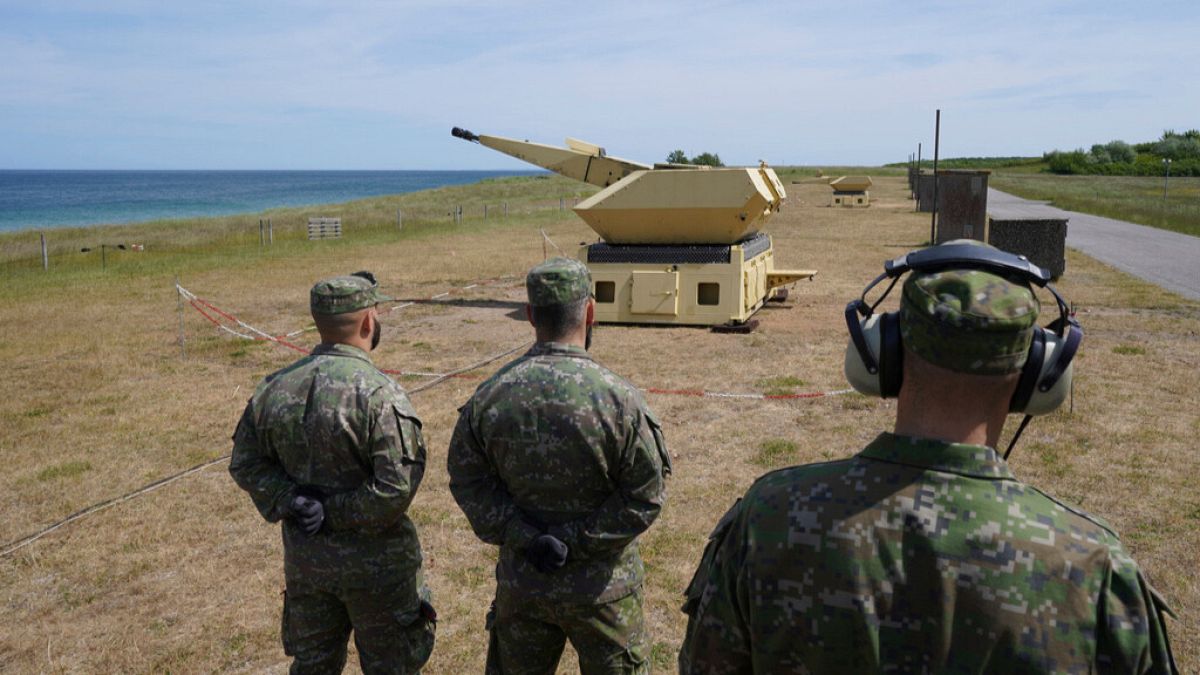Education
In High School Gilgo Beach Suspect Was an Angry Loner, Classmates Say

The members of the class of 1983 slapped on their 40th reunion name tags and hit the open bar to reminisce. They squeezed into Johnny McGorey’s Pub across from the Massapequa Park train station on Long Island last weekend, among them former athletes, prom sweethearts and yearbook fixtures.
But the buzz of the reunion was the phantom of Berner High School: Rex Heuermann had suddenly made a name for himself days before, when prosecutors accused him of being a serial killer.
Mr. Heuermann, a 59-year-old architect and high school nobody who had lived his life several blocks from the bar, was arrested July 13. He was charged with killing three women found buried in 2010 near Gilgo Beach on Long Island’s South Shore, and is the prime suspect in the death of a fourth. In all, 11 bodies have been found on the miles-long stretch of shore.
Mr. Heuermann has pleaded not guilty, but his arrest created a sensation, drawing crowds to watch investigators carry evidence from his dilapidated ranch house. Ranks of television cameras and even drones recorded the excavation of the backyard. The news loop on the bar’s television screens broadcast continuous images of the man who had been a reclusive teen at Berner’s margins, sidestepping hallway society, a stranger to the cool-kid cafeteria tables.
At Johnny McGorey’s, the old classmates assessed each other, their inevitable hair loss and weight gain, and then measured how Mr. Heuermann had held up. His face had hardened, they observed, and his gawky frame was now hulking. The goofy glasses were gone, but he still had that mop of hair.
Classmates who remembered Mr. Heuermann, who graduated two grades ahead of them, described him as a victim, albeit one with a mean streak, whose home life was difficult and school life was worse. He was a loner, they said, and a target.
“He was everybody’s punching bag,” said John Parisi, who said Mr. Heuermann never really fell into cliques like jocks, nerds or burnouts.
“He got picked on a lot,” Mr. Parisi said. “He would take it and take it and walk away. I seen him pushed to his limit.”
In sixth grade, a group of students had “singled out” the tall, awkward boy and tried to beat him up. After being stopped by a teacher, they tortured him verbally. But in high school, Mr. Heuermann grew larger and more menacing, said Mr. Parisi, who graduated in 1983.
“I was really scared of him. He was the type of guy if he snapped he could really hurt you,” Mr. Parisi said. “He was disillusioned and he was misguided. You had to be very careful.”
Mr. Heuermann came of age in a New York suburb laid out on a tight grid of streets an hour from Midtown Manhattan, with measures of celebrity and notoriety alike. It spawned the acting Baldwin brothers and Jerry Seinfeld, but also Joey Buttafuoco, the swaggering auto body guy whose teenage mistress, Amy Fisher, shot his wife, Mary Jo, at her front door in 1992. Notorious crimes became part of the local lore, including serial killers like the Son of Sam who terrorized nearby Queens, and Joel Rifkin, who went to high school several towns away in East Meadow.
Berner High School is a squat, tan brick structure on the edge of town that students 40 years ago reached by Schwinn or Camaro. Its social groups had rituals: The jocks took trips to the beach and hung out at All American Hamburger Drive-In. The burnouts had Zappa Woods, a leafy hideaway where they could smoke weed and blast Led Zeppelin and the Doors.
Mr. Heuermann, unathletic and uncool, remained “an outcast,” said Dan Musto, 55, who said he knew him growing up. Mr. Heuermann did join the drama club as a stagehand. In a yearbook photo, he towers in the back row above the rest of the students, looking shy in large-framed glasses with his hair unstyled in a world of perfect feathering.
And after commencement on the Berner Bison football field, Mr. Heuermann remained removed from the alumni groups, reunions and eventual social media pages for graduates, even as bodies kept turning up on Gilgo Beach.
Over the past dozen years, the murders riveted locals. After numerous dead ends, investigators began closing in on Mr. Heuermann last year with the help of DNA analysis, cellphone records and a witness’s account of seeing a Chevrolet Avalanche like Mr. Heuermann’s.
For some last weekend, it was hard to reconcile the gawky, shy kid on the margins with the man authorities call a sadistic serial killer who preyed on women who worked as escorts. They say he wrapped them in hunting burlap, dropping them along a desolate stretch of Ocean Parkway a short drive from this very reunion, and within walking distance of the school’s favorite beach, Tobay.
“It’s a shock. We knew him,” said Michael Sean Fagan, speaking above a room filled with animated conversation and blaring retro soundtrack. “He was nerdy, smart.”
Others said the arrest made a piece fall into place.
“When I heard they arrested him, I was not surprised at all,” Don Ophals, who attended kindergarten through 12th grade with Mr. Heuermann, said in a telphone interview. “I said, ‘Oh my god, it fits perfectly.’ That’s the weird guy.”
“He was a recluse, very quiet,” said Mr. Ophals, a champion wrestler in high school and now a healthcare executive. “You just saw him as a guy by himself. He barely spoke.”
“He was seen as weird, someone you didn’t see eye to eye with.”
In another phone interview, the actor Billy Baldwin, who starred in “Backdraft,” said he had attended junior high and high school with Mr. Heuermann and had known him in passing, to say hello in the hallways and in shared classes. Mr. Baldwin also said Mr. Heuermann never fit into clearly established cliques, “but I also didn’t think he was so weird, so creepy or so unusual that it would lead to something like this.”
“He was a bit shy, a bit insecure, a bit uncomfortable,” he said. “I wouldn’t say he was an outcast but he struggled to fit in and to find his crowd.”
The struggle started early. Mr. Heuermann grew up with three older sisters and a younger brother. His father, Ted, was an aerospace engineer who enjoyed specialty woodworking, a hobby the adult Mr. Heuermann would emulate, making furniture in his garage.
But according to Mr. Musto, it was well known that Mr. Heuermann had clashed with his father, who was tough on the boy for not being a go getter. In response, Rex acted out. He got caught after engaging in a shoplifting spree, Mr. Musto said.
“Why is he getting in trouble? He’s fighting with his dad,” Mr. Musto said. “It was common knowledge.”
His father died when Mr. Heuermann was on the cusp of adolescence. It was 1975, when Rex was 12. After that, the children were raised by their mother, Dolores, now 93 and living in upstate New York.
Mr. Ophals said that in grade school, he once fought Rex simply because his older brother told him to, and prevailed easily. Back then, Mr. Ophals said, bullying was not monitored as it is today.
“That was just how it was at that time,” Mr. Ophals said. “You played the cards you were dealt.”
John DeMicoli, who grew up near the Heuermann’s rundown home on First Avenue, said young Rex preferred to remain at home, and essentially opted out of social life.
One thing Rex enjoyed was architectural drawing class, he said, “but when classmates would try to talk to him, he didn’t have the social skills to hold a conversation — just a very weird character.”
He was also known for fighting back after he was pushed past his limit.
“He had a mean streak in him,” Mr. DeMicoli said.
After graduating, Mr. Heuermann spent several years doing part-time cleaning and maintenance at Jones Beach, which is several miles west of Gilgo Beach, and also frequented Tobay Beach, which lies between.
Mr. Baldwin, who worked several summers as a Tobay lifeguard, said he saw Mr. Heuermann there periodically. Mr. Baldwin called it “very disturbing and ironic” that Mr. Heuermann had been charged with “burying bodies in the dunes, just walking distance from my lifeguard stand.”
Mr. Heuermann went on to college at New York Institute of Technology on Long Island to study architectural technology. He eventually started his own business in Manhattan as an architectural consultant and became proficient at making sure renovations followed intricate building codes — tormenting many of the contractors and homeowners he dealt with.
As a married father, he bought his family home in the 1990s and let it fall into disrepair as surrounding properties soared in value and were renovated.
One of the few neighbors Mr. Heuermann spoke to was Etienne de Villiers, 68, whose immaculately kept house next door stood in keen contrast with Mr. Heuermann’s. Mr. de Villiers said he had only passing conversations with Mr. Heuermann along with a few minor conflicts, like the time he had to tell Mr. Heuermann to stop leering at his wife over the backyard fence while she was sunbathing.
Mr. de Villiers watched as Mr. Heuermann seemed to be raising his children to be as isolated as he had been, in the same rundown off-limits house. He said that when Mr. Heuermann’s daughter Victoria, now 26, got her license, “I wanted to tell her, ‘Just get in your car and drive and never come back.’”
At Johnny McGorey’s Pub, Mr. DeMicoli was more concerned with raising a glass with former classmates than dwelling on Mr. Heuermann. But he recalled once when he and his friends had tried to the recruit the huge, awkward boy into their street hockey game. “He would have been a great goalie,” he said, almost wistfully.
The brief effort at inclusion came to nothing.
“He just didn’t want any part of it, he didn’t want any part of sports,” Mr. DeMicoli said. “He didn’t want any part of anything.”
Andy Newman contributed reporting.

Education
Four Fraternity Members Charged After a Pledge Is Set on Fire

Four fraternity members at San Diego State University are facing felony charges after a pledge was set on fire during a skit at a party last year, leaving him hospitalized for weeks with third-degree burns, prosecutors said Monday.
The fire happened on Feb. 17, 2024, when the Phi Kappa Psi fraternity held a large party at its house, despite being on probation, court documents show. While under probation, the fraternity was required to “demonstrate exemplary compliance with university policies,” according to the college’s guidelines.
Instead, prosecutors said, the fraternity members planned a skit during which a pledge would be set on fire.
After drinking alcohol in the presence of the fraternity president, Caden Cooper, 22, the three younger men — Christopher Serrano, 20, and Lars Larsen, 19, both pledges, and Lucas Cowling, 20 — then performed the skit, prosecutors said.
Mr. Larsen was set on fire and wounded, prosecutors said, forcing him to spend weeks in the hospital for treatment of third-degree burns covering 16 percent of his body, mostly on his legs.
The charges against Mr. Cooper, Mr. Cowling and Mr. Serrano include recklessly causing a fire with great bodily injury; conspiracy to commit an act injurious to the public; and violating the social host ordinance. If convicted of all the charges, they would face a sentence of probation up to seven years, two months in prison.
Mr. Larsen himself was charged. The San Diego County District Attorney’s office said that he, as well as Mr. Cooper and Mr. Cowling, also tried to lie to investigators in the case, deleted evidence on social media, and told other fraternity members to destroy evidence and not speak to anyone about what happened at the party.
All four men have pleaded not guilty.
Lawyers representing Mr. Cooper and Mr. Cowling did not immediately respond to messages requesting comment on Tuesday. Contact information for lawyers for Mr. Serrano and Mr. Larsen was not immediately available.
The four students were released on Monday, but the court ordered them not to participate in any fraternity parties, not to participate in any recruitment events for the fraternity, and to obey all laws, including those related to alcohol consumption.
The university said Tuesday that it would begin its own administrative investigation into the conduct of the students and the fraternity, now that the police investigation was complete.
After it confirmed the details, the dean of students office immediately put the Phi Kappa Psi chapter on interim suspension, which remains in effect, college officials confirmed on Tuesday.
Additional action was taken, but the office said it could not reveal specifics because of student privacy laws.
“The university prioritizes the health and safety of our campus community,” college officials said in a statement, “and has high expectations for how all members of the university community, including students, behave in the interest of individual and community safety and well-being.”
At least half a dozen fraternities at San Diego State University have been put on probation in the last two years, officials said.
Education
Video: Several Killed in Wisconsin School Shooting, Including Juvenile Suspect

new video loaded: Several Killed in Wisconsin School Shooting, Including Juvenile Suspect
transcript
transcript
Several Killed in Wisconsin School Shooting, Including Juvenile Suspect
The police responded to a shooting at a private Christian school in Madison, Wis., on Monday.
-
Around 10:57 a.m., our officers were responding to a call of an active shooter at the Abundant Life Christian School here in Madison. When officers arrived, they found multiple victims suffering from gunshot wounds. Officers located a juvenile who they believe was responsible for this deceased in the building. I’m feeling a little dismayed now, so close to Christmas. Every child, every person in that building is a victim and will be a victim forever. These types of trauma don’t just go away.
Recent episodes in Guns & Gun Violence
Education
Video: Biden Apologizes for U.S. Mistreatment of Native American Children

new video loaded: Biden Apologizes for U.S. Mistreatment of Native American Children
transcript
transcript
Biden Apologizes for U.S. Mistreatment of Native American Children
President Biden offered a formal apology on Friday on behalf of the U.S. government for the abuse of Native American children from the early 1800s to the late 1960s.
-
The Federal government has never, never formally apologized for what happened until today. I formally apologize. It’s long, long, long overdue. Quite frankly, there’s no excuse that this apology took 50 years to make. I know no apology can or will make up for what was lost during the darkness of the federal boarding school policy. But today, we’re finally moving forward into the light.
Recent episodes in Politics
-

 Business1 week ago
Business1 week agoThese are the top 7 issues facing the struggling restaurant industry in 2025
-

 Culture1 week ago
Culture1 week agoThe 25 worst losses in college football history, including Baylor’s 2024 entry at Colorado
-

 Sports1 week ago
Sports1 week agoThe top out-of-contract players available as free transfers: Kimmich, De Bruyne, Van Dijk…
-

 Politics6 days ago
Politics6 days agoNew Orleans attacker had 'remote detonator' for explosives in French Quarter, Biden says
-

 Politics5 days ago
Politics5 days agoCarter's judicial picks reshaped the federal bench across the country
-

 Politics4 days ago
Politics4 days agoWho Are the Recipients of the Presidential Medal of Freedom?
-

 Health3 days ago
Health3 days agoOzempic ‘microdosing’ is the new weight-loss trend: Should you try it?
-

 World1 week ago
World1 week agoIvory Coast says French troops to leave country after decades














